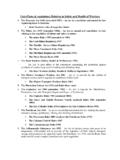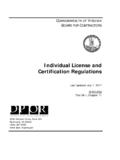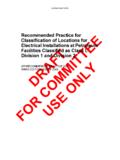Transcription of Portable petrol storage containers - Health and Safety ...
1 Health and Safety ExecutivePage 1 of 7 Portable petrol storage containersThe petroleum (Consolidation) regulations 2014 (PCR), which came into force on 1 October 2014, apply to the following: workplaces that store petrol where petrol is dispensed, ie retail and non-retail petrol filling stations; non-workplace premises storing petrol , for example at private homes, or at clubs/associations (or similar). This guidance provides for suitable Portable petrol storage containers that satisfy the requirements of regulations 12, 13, 19, 22 and Schedule 3 of the PCR. It gives practical advice on the design, construction, materials and marking or labelling of containers as required by the PCR, specifies certain construction and performance requirements, together with type testing and production testing procedures that can be used to demonstrate that these requirements are satisfied. General principlesThe guidance sets out the general principles for the design and manufacture of Portable petrol storage containers with specific guidance for the design and construction of plastic and metal containers respectively.
2 The general principles for the design and manufacture of Portable petrol storage containers require that they must: have a nominal capacity: no greater than 10 litres if made of plastic; no greater than 20 litres if made of metal; have a total capacity between 10% and 15% more than the nominal capacity; be made of either metal or plastic that is suitable and safe for the purpose and will not significantly degrade due to exposure to petrol or naturally occurring ultraviolet radiation; be designed and constructed so that: they are reasonably robust and not liable to break under the normal conditions of use; the escape of liquid or vapour is prevented; petrol can be poured safely from them; they are not unsteady when placed on a flat surface; be marked or labelled in a legible and indelible form with: the words petrol and HIGHLY FLAMMABLE; an appropriate hazard warning sign; the nominal capacity in litres; the manufacturer s name and the date and month of manufacture.
3 Health and Safety ExecutivePortable petrol storage containers Page 2 of 7 Plastic containers materialsPlastic containers should be made of a moulded polyethylene with a specification suitable for the intended purpose, regarding the characteristics of petrol and the general requirements as set out in the PCR. The containers must be suitable for the intended purpose and, as such, the composition of the material should be known. Although there is currently no International, European or British Standard for the storage of petrol in plastic containers , a UN approved plastic container meeting the performance requirements for the carriage of petrol under the European Agreement Concerning the International Carriage of Dangerous Goods by Road (ADR) would be considered robust for most storage container should be of adequate strength in relation to its intended purpose, eg materials such as virgin high-density polyethylene (HDPE) would meet this need.
4 Polyethylenes of uncontrolled composition and mixtures of different grades should not be used. It is recommended that dilution with recycled materials is avoided as it may not be a known or consistent composition and may result in a composition material of lower strength and higher permeability. Plastic containers are not intended for storage in direct sunlight. The container material must be of such a composition that the performance characteristics are not significantly diminished by the adverse effect of exposure to naturally occurring ultraviolet (UV) radiation. The construction material should therefore include adequate UV stabilisation and materials manufactured using hindered amine light stabilisers (HALS) provide efficient stabilisers against light-induced degradation of most polymers. They do not absorb UV radiation, but inhibit degradation of the polymer and are therefore capable of providing long-term thermal and light stability.
5 However, the degradation rate of the container will be susceptible to storage conditions. Anti-spill spout adaptors are available that can be used to prevent flashback of flames and internal explosions when pouring petrol from plastic petrol containers . These adaptors can either be used in place of the spout supplied or may be integrated into the design of the petrol container . A study by HSL ( ) on a sample of these adaptors has demonstrated that they are capable of preventing flashback but can have limitations in their ability to prevent overfill and spillage. They therefore do not eliminate all the risk involved in using petrol and care is still needed when using them to avoid spillages and accidents. Metal containers materialsAlthough there is currently no International, European or British Standard for the storage of petrol in metal containers , a UN approved metal container meeting the performance requirements for the carriage of petrol under ADR would be considered robust for most storage containers should be made of a suitably robust construction such as steel sheet or aluminium, and of adequate thickness in relation to the capacity of the container and its intended purpose.
6 A metal container that meets the packaging requirements under ADR would be considered suitable and robust for most storage conditions. Health and Safety ExecutivePortable petrol storage containers Page 3 of 7 General requirements for plastic and metal containersCapacity and designThe nominal capacity of the container is the maximum volume of liquid the container is intended to hold at 20 C, ie no greater than 10 litres if made of plastic and no greater than 20 litres if made of metal. The total capacity of containers must be between 10% and 15% more than the nominal capacity (ie the maximum volume of liquid that the container would hold if filled to the brim). This will allow space for the petrol to expand, eg where the container may be exposed to heat gain. The lids or tops should be well-fitting and made of suitable material to remain secure and prevent the escape or leakage of liquid or vapour, with the closure providing an effective seal at all times when applied.
7 The closure should not show any visible signs of leaking even if the container is on its side or accidentally tipped over. Any opening for filling should allow for the safe filing of petrol from a petrol pump without using a funnel. Any containers equipped with a pouring spout, should be able to be firmly attach it to the opening to allow emptying without colourThere are NO restrictions on the colour for plastic or metal containers but general custom and practice is that green is used for unleaded petrol and black for diesel. Labelling All containers must be clearly and correctly labelled so people are aware of their contents and hazards. All containers must be marked or labelled in a legible and indelible form with: the words petrol and HIGHLY FLAMMABLE ; an appropriate hazard warning sign, for example: the nominal capacity of the container in litres; the manufacturers name and the date and month of and Safety ExecutivePortable petrol storage containers Page 4 of 7 Design type and production testingTo ensure that petrol storage containers satisfy the specific requirements set out in PCR, design type testing and production testing procedures should be carried out on a sample number of containers by an independent person or competent body.
8 Metal and plastic petrol containers should be subject to, and capable of, meeting the test levels appropriate to the container . A UN approved metal or plastic container that meets the performance requirements for the carriage of petrol under ADR would be considered robust for most storage containers should therefore be tested in accordance with the performance requirements in Chapter of ADR ( ). Plastic petrol containers should be tested in accordance with the design type testing outlined later in this document under Type testing Plastic petrol containers . However, plastic petrol containers that meet the performance requirements for the carriage of petrol under ADR would be considered suitable for storage . Before carrying out the tests, containers should be selected for testing where each individual weight (without cap and accessories, where possible) does not differ by more than 5% from the mean weight of the total sample of containers .
9 The sample containers should be examined before testing to ensure they meet the capacity and design requirements. On completion of successful testing, the person or competent body carrying out the tests should certify that the containers are suitable and safe for the and wall thicknessEach of the containers should be weighed, where possible, without cap and pouring spout and the weight of the lightest of the sample containers should be determined. This is then considered to be the minimum container weight for further production. The smallest wall thickness should be determined to the nearest from the three lightest containers selected as samples. The smallest wall thickness is considered to be the minimum wall thickness for further production. Each of the following type tests should be carried out on three containers per test, all of which should satisfy the requirements of the respective tests. If any container does not satisfy the requirements of the test in any respect, that container type should be deemed to have failed the type test.
10 Design type testing should be carried out in the following sequence: Strength: Impact (drop) test The containers should remain intact and show no visible leakage when subjected to dropping through a vertical height of m onto an unyielding surface, in accordance with the test method applicable to the container . Tightness of closure test The closure should provide an effective seal at all times when applied. The closure should show no sign of leakage when subjected to internal pressure, in accordance with the test method applicable to the container . Strength: Internal pressure test The containers should remain intact and show no sign of leakage when subjected to internal pressure, in accordance with the test method applicable to the container . Health and Safety ExecutivePortable petrol storage containers Page 5 of 7 Permeability test (plastic petrol containers only) The contents of the closed container should lose no more than 5 g in weight when a full container is kept for 4 hours at a temperature of +75 C, in accordance with the test method for plastic petrol containers .
















